Dynamical Downscaling of Daily Extreme Temperatures over China Using PRECIS Model
Abstract
:1. Introduction
2. Data and Methods
2.1. PRECIS Regional Climate Model
2.2. Data
3. Results
3.1. Historical Validation
3.2. Future Changes
3.2.1. Changes in Spatial Distribution
3.2.2. Annual Cycle Changes


4. Discussions
5. Conclusions
Supplementary Materials
Author Contributions
Funding
Institutional Review Board Statement
Informed Consent Statement
Data Availability Statement
Conflicts of Interest
References
- Ma, Y.; Li, H.; Qin, P.; Cheng, B.; Feng, F.; Zhang, Y.; Jiao, H. Extreme temperatures and circulatory mortality in a temperate continental monsoon climate city in Northeast China. Environ. Sci. Pollut. Res. 2023, 30, 21661–21670. [Google Scholar] [CrossRef] [PubMed]
- Meehl, G.A.; Karl, T.; Easterling, D.R.; Changnon, S.; Pielke, R., Jr.; Changnon, D.; Evans, J.; Groisman, P.Y.; Knutson, T.R.; Kunkel, K.E.; et al. An introduction to trends in extreme weather and climate events: Observations, socioeconomic impacts, terrestrial ecological impacts, and model projections. Bull. Am. Meteorol. Soc. 2000, 81, 413–416. [Google Scholar] [CrossRef]
- IPCC. Climate Change 2014: Synthesis Report. In Contribution of Working Groups I, II and III to the Fifth Assessment Report of the Intergovernmental Panel on Climate Change; Pachauri, R.K., Meyer, L.A., Eds.; IPCC: Geneva, Switzerland, 2014; p. 151. [Google Scholar]
- Cole, S. Fourth warmest year in continued warming trend, according to NASA. In NOAA News February 2018; NASA: Washington, DC, USA, 2019; Volume 6. [Google Scholar]
- Garg, T.; Gibson, M.; Sun, F. Extreme temperatures and time use in China. J. Econ. Behav. Organ. 2020, 180, 309–324. [Google Scholar] [CrossRef]
- Wu, Z.; Chen, Q. “General Mobilization” in Hubei Province to fight against snow and ice disaster. National Business Daily, 8 February 2024. [Google Scholar]
- Beijing Daily. 41.1 °C! June 22 High temperature broke the city in June historical extreme high temperature orange alert issued 23, 24 days may still reach 40 °C. Beijing Daily, 23 June 2023. [Google Scholar]
- Nayak, S.; Mandal, M.; Maity, S. Assessing the impact of Land-use and Land-cover changes on the climate over India using a Regional Climate Model (RegCM4). Clim. Res. 2021, 85, 1–20. [Google Scholar] [CrossRef]
- Trinh, T.Q. Modeling high-resolution precipitation by means of a regional climate model coupled with a machine learning algorithms: Application to Dong Nai-Sai Gon river watershed. AGU Fall Meet. Abstr. 2020, 2020, H165-0008. [Google Scholar]
- Rajbhandari, R.; Shrestha, A.B.; Kulkarni, A.; Patwardhan, S.K.; Bajracharya, S.R. Projected changes in climate over the Indus river basin using a high resolution regional climate model (PRECIS). Clim. Dyn. 2015, 44, 339–357. [Google Scholar] [CrossRef]
- Torabi, M.; Shokoohi, A. Extracting and Evaluating Future Intensity-Duration-Frequency Curves of the Present Century Using Dynamic Time and Space Down-Scaling (Case Study: Rasht City). Iran. J. Soil Water Res. 2023, 54, 429–440. [Google Scholar]
- Wang, X.; Guo, J.; Fenech, A.; Farooque, A.A. Future climate projections for Eastern Canada. Clim. Dyn. 2022, 59, 2735–2750. [Google Scholar] [CrossRef]
- Li, Y.; Chang, J.; Gao, X.; Zhang, L.; Wang, L.; Ren, C. A case study on the impacts of future climate change on soybean yield and countermeasures in Fujin city of Heilongjiang province, China. Front. Agron. 2024, 6, 1257830. [Google Scholar] [CrossRef]
- Lu, G.-H.; Xiao, H.; Wu, Z.-Y.; Zhang, S.-L.; Li, Y. Assessing the impacts of future climate change on hydrology in Huang-Huai-Hai region in China using the PRECIS and VIC models. J. Hydrol. Eng. 2013, 18, 1077–1087. [Google Scholar] [CrossRef]
- Zhang, M.; Guo, Z.-Y.; Dong, G.-T.; Tan, J.-G. Projected heat wave increasing trends over China based on combined dynamical and multiple statistical downscaling methods. Adv. Clim. Chang. Res. 2023, 14, 758–767. [Google Scholar] [CrossRef]
- Zhang, L.; Xu, Y.; Meng, C.; Li, X.; Liu, H.; Wang, C. Comparison of statistical and dynamic downscaling techniques in generating high-resolution temperatures in China from CMIP5 GCMs. J. Appl. Meteorol. Climatol. 2020, 59, 207–235. [Google Scholar] [CrossRef]
- Bowling, L.C.; Lettenmaier, D.P.; Nijssen, B.; Graham, L.; Clark, D.B.; El Maayar, M.; Essery, R.; Goers, S.; Gusev, Y.M.; Habets, F.; et al. Simulation of high-latitude hydrological processes in the Torne-Kalix basin: PILPS Phase 2 (e): 1: Experiment description and summary intercomparisons. Glob. Planet. Chang. 2003, 38, 1–30. [Google Scholar] [CrossRef]
- Cao, L.; Dong, W.; Xu, Y.; Zhang, Y.; Sparrow, M. Validating the runoff from the PRECIS model using a large-scale routing model. Adv. Atmos. Sci. 2007, 24, 855–862. [Google Scholar] [CrossRef]
- Rew, R.; Davis, G. NetCDF: An interface for scientific data access. IEEE Comput. Graph. Appl. 1990, 10, 76–82. [Google Scholar] [CrossRef]
- Nicholls, Z.; Lewis, J.; Makin, M.; Nattala, U.; Zhang, G.Z.; Mutch, S.J.; Tescari, E.; Meinshausen, M. Regionally aggregated, stitched and de-drifted CMIP-climate data, processed with netCDF-SCM v2. 0.0. Geosci. Data J. 2021, 8, 154–198. [Google Scholar] [CrossRef]
- Luo, Y.; Xu, C.; Chu, Z.; Sun, Q.; Chen, L. Application of CN05. 1 meteorological data in watershed hydrological simulation: A case study in the upper reaches of Kaidu River basin. Adv. Clim. Chang. Res. 2020, 16, 287. [Google Scholar]
- Luan, L.; Zhai, P. Changes in rainy season precipitation properties over the Qinghai-Tibet Plateau based on multi-source datasets. Adv. Clim. Chang. Res. 2023, 19, 173. [Google Scholar]
- Yang, L.; Liang, X.; Yin, J.; Xie, Y.; Fan, H. Evaluation of the Precipitation of the East Asia regional reanalysis system mainly over mainland China. Int. J. Climatol. 2023, 43, 1676–1692. [Google Scholar] [CrossRef]
- Xin, X.; Wu, T.; Zhang, J.; Li, W.; Zhang, Y.; Fang, Y.; Jie, W.; Zhang, L.; Shi, X.; Li, J.; et al. Introduction of BCC models and its participation in CMIP6. Adv. Clim. Chang. Res. 2019, 15, 533. [Google Scholar]
- Yu, E.; Sun, J.; Chen, H.; Xiang, W. Evaluation of a high-resolution historical simulation over China: Climatology and extremes. Clim. Dyn. 2014, 45, 2013–2031. [Google Scholar] [CrossRef]
- Wu, J.; Gao, X.J. A gridded daily observation dataset over China region and comparison with the other datasets. Chin. J. Geophys. 2013, 56, 1102–1111. (In Chinese) [Google Scholar]
- Guo, D.; Wang, H. Comparison of a very-fine-resolution GCM with RCM dynamical downscaling in simulating climate in China. Adv. Atmos. Sci. 2016, 33, 559–570. [Google Scholar] [CrossRef]
- Maraun, D. Bias Correction, Quantile Mapping, and Downscaling: Revisiting the Inflation Issue. J. Clim. 2013, 26, 2137–2143. [Google Scholar] [CrossRef]
- Cannon, A.J.; Sobie, S.R.; Murdock, T.Q. Bias Correction of GCM Precipitation by Quantile Mapping: How Well Do Methods Preserve Changes in Quantiles and Extremes? J. Clim. 2015, 28, 6938–6959. [Google Scholar] [CrossRef]
- Cannon, A.; Piani, C.; Sippel, S. Bias correction of climate model output for impact models. In Climate Extremes and Their Implications for Impact and Risk Assessment; Elsevier: Amsterdam, The Netherlands, 2020; pp. 77–104. [Google Scholar]
- Kusumastuti, C.; Jiang, Z.; Mehrotra, R.; Sharma, A. A signal processing approach to correct systematic bias in trend and variability in climate model simulations. Geophys. Res. Lett. 2021, 48, e2021GL092953. [Google Scholar] [CrossRef]
- Nie, S.; Fu, S.; Cao, W.; Jia, X. Comparison of monthly air and land surface temperature extremes simulated using CMIP5 and CMIP6 versions of the Beijing Climate Center climate model. Theor. Appl. Climatol. 2020, 140, 487–502. [Google Scholar] [CrossRef]
- Wu, T.; Lu, Y.; Fang, Y.; Xin, X.; Li, L.; Li, W.; Jie, W.; Zhang, J.; Liu, Y.; Zhang, L.; et al. The Beijing Climate Center climate system model (BCC-CSM): The main progress from CMIP5 to CMIP6. Geosci. Model Dev. 2019, 12, 1573–1600. [Google Scholar] [CrossRef]
- Xu, W.; Lin, T.; Lei, X.; Chen, Y.; Gao, L. Anthropogenic emissions and land use/cover change contributions to extreme temperature changes over China. Atmos. Res. 2023, 292, 106845. [Google Scholar] [CrossRef]
- Qiu, J.; Yang, X.; Cao, B.; Chen, Z.; Li, Y. Effects of urbanization on regional extreme-temperature changes in China, 1960–2016. Sustainability 2020, 12, 6560. [Google Scholar] [CrossRef]

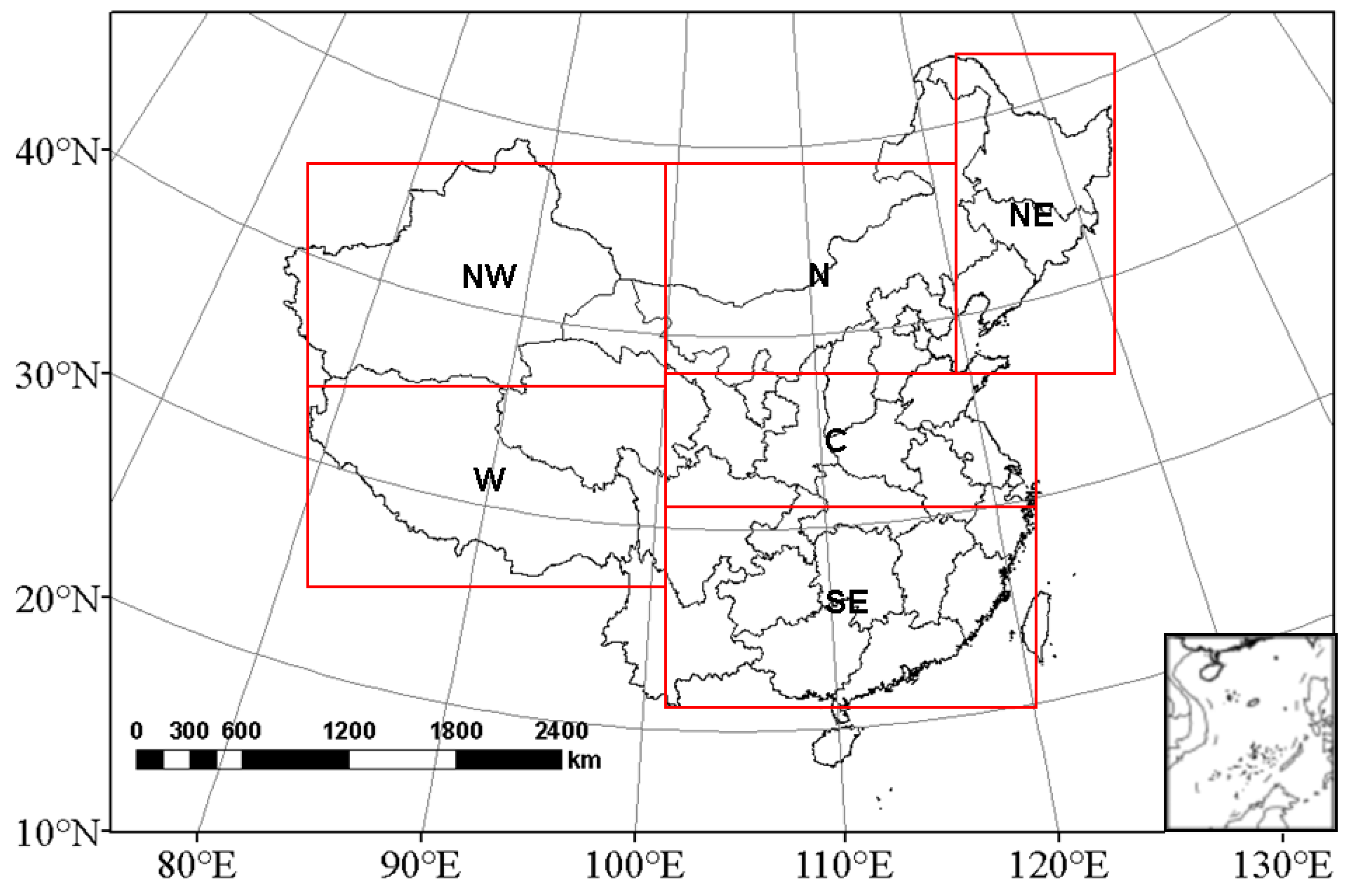
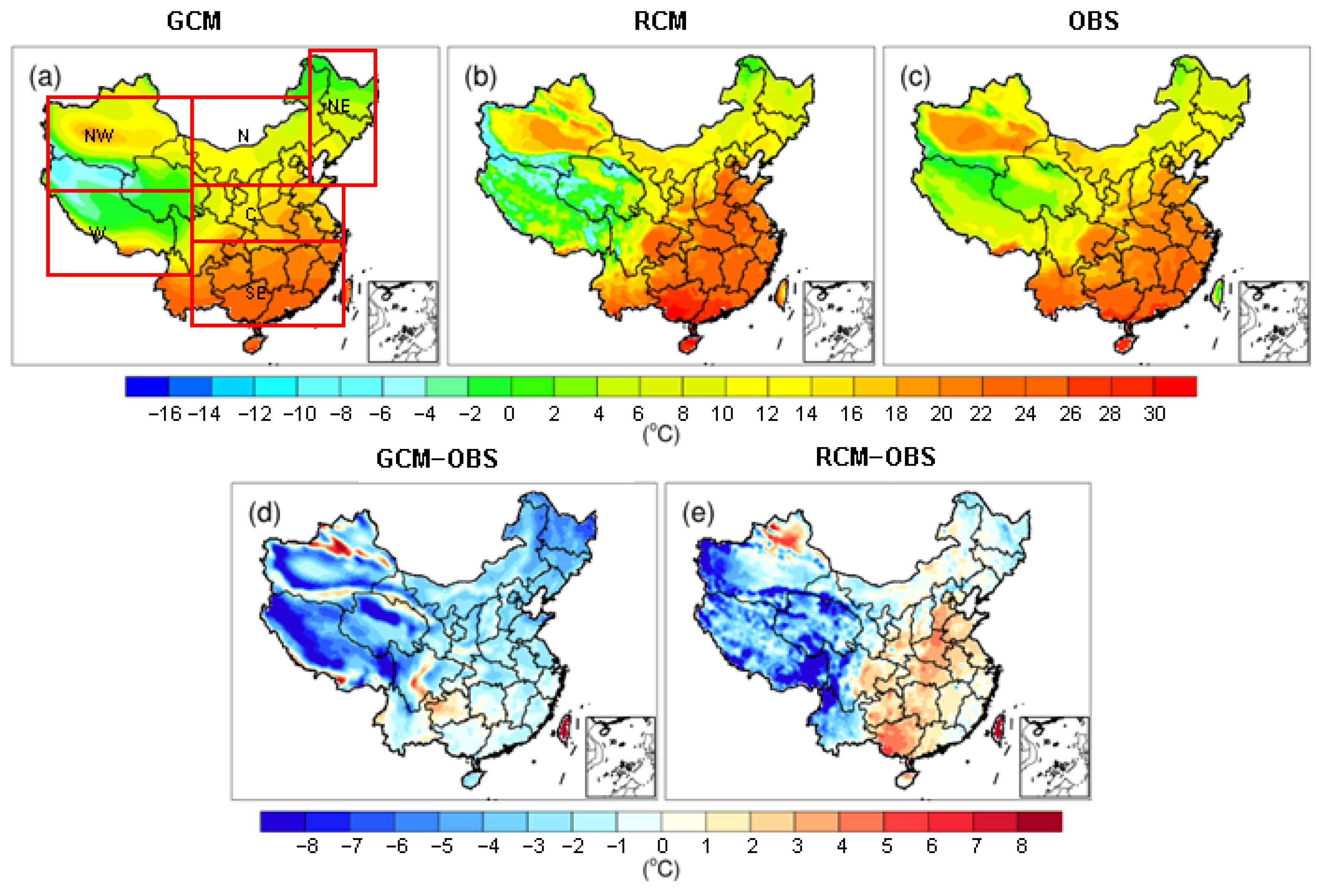
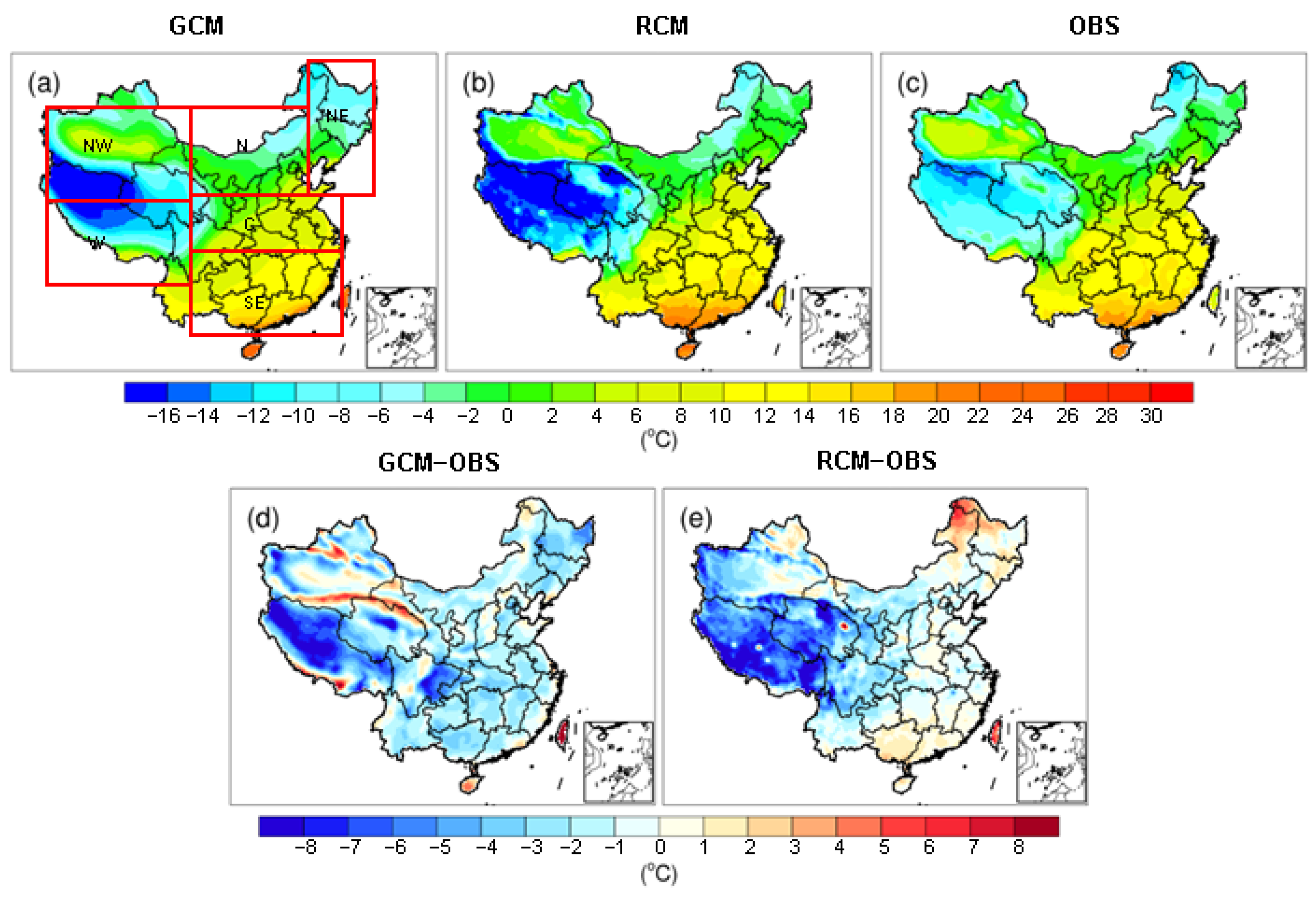
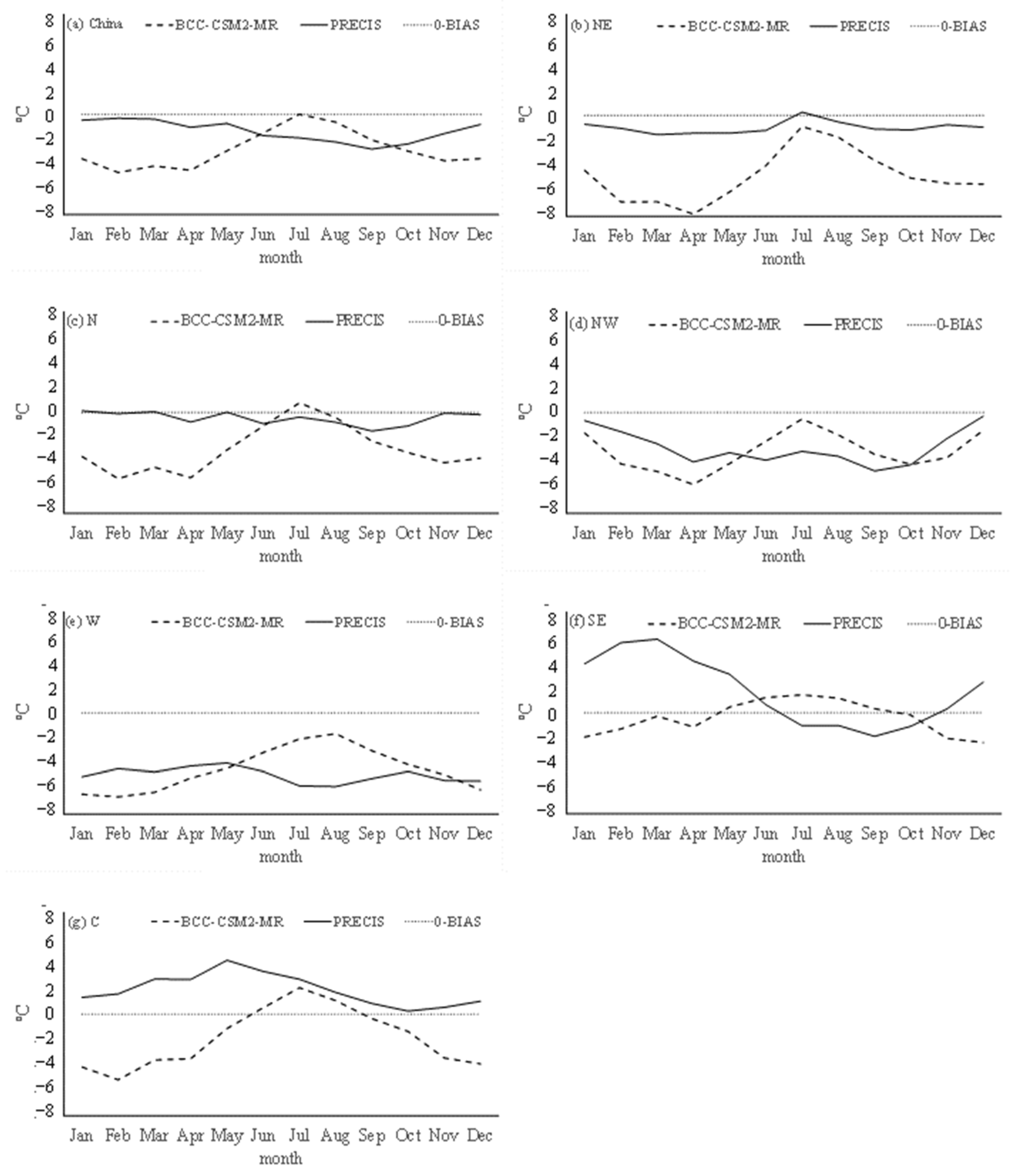
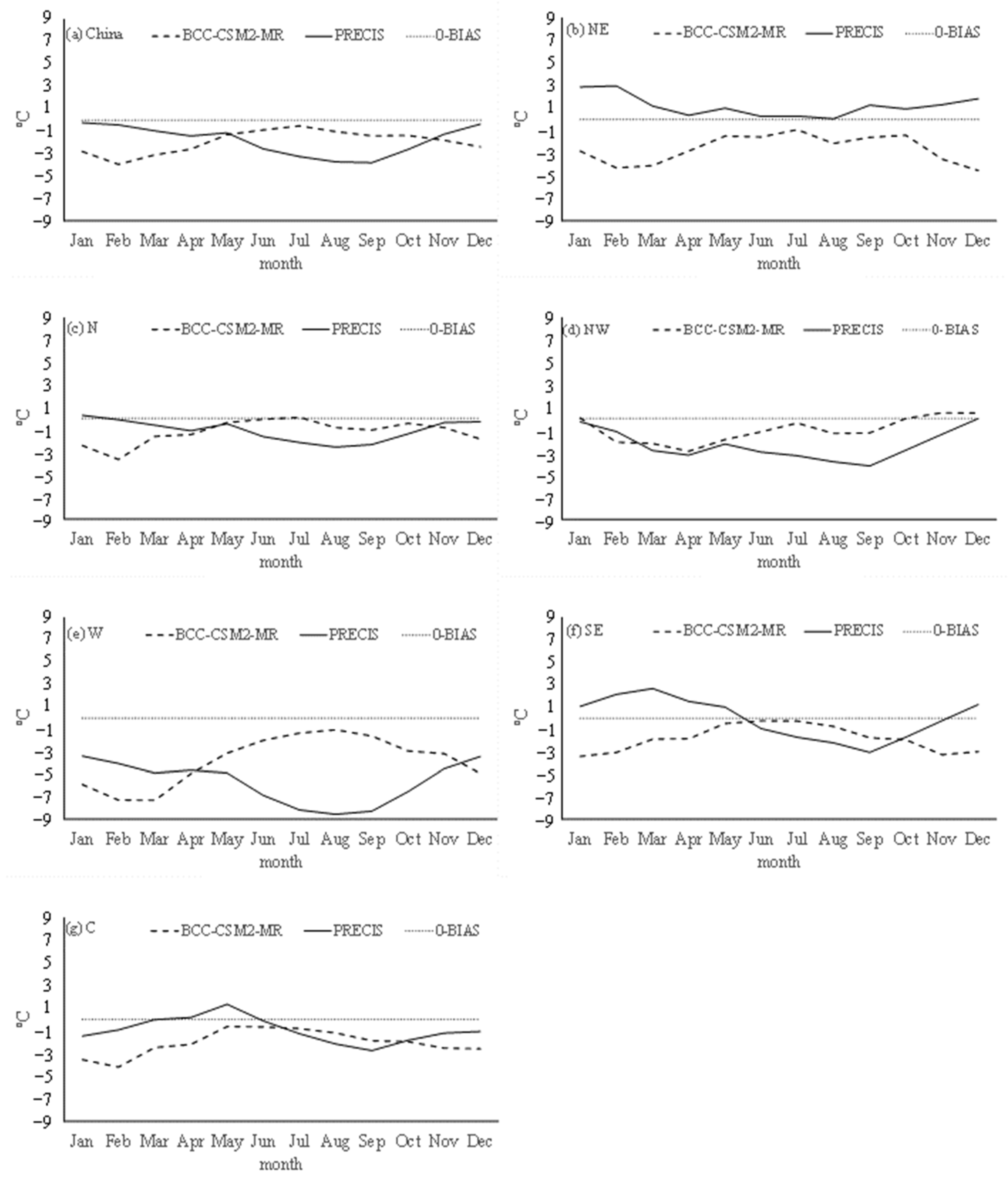
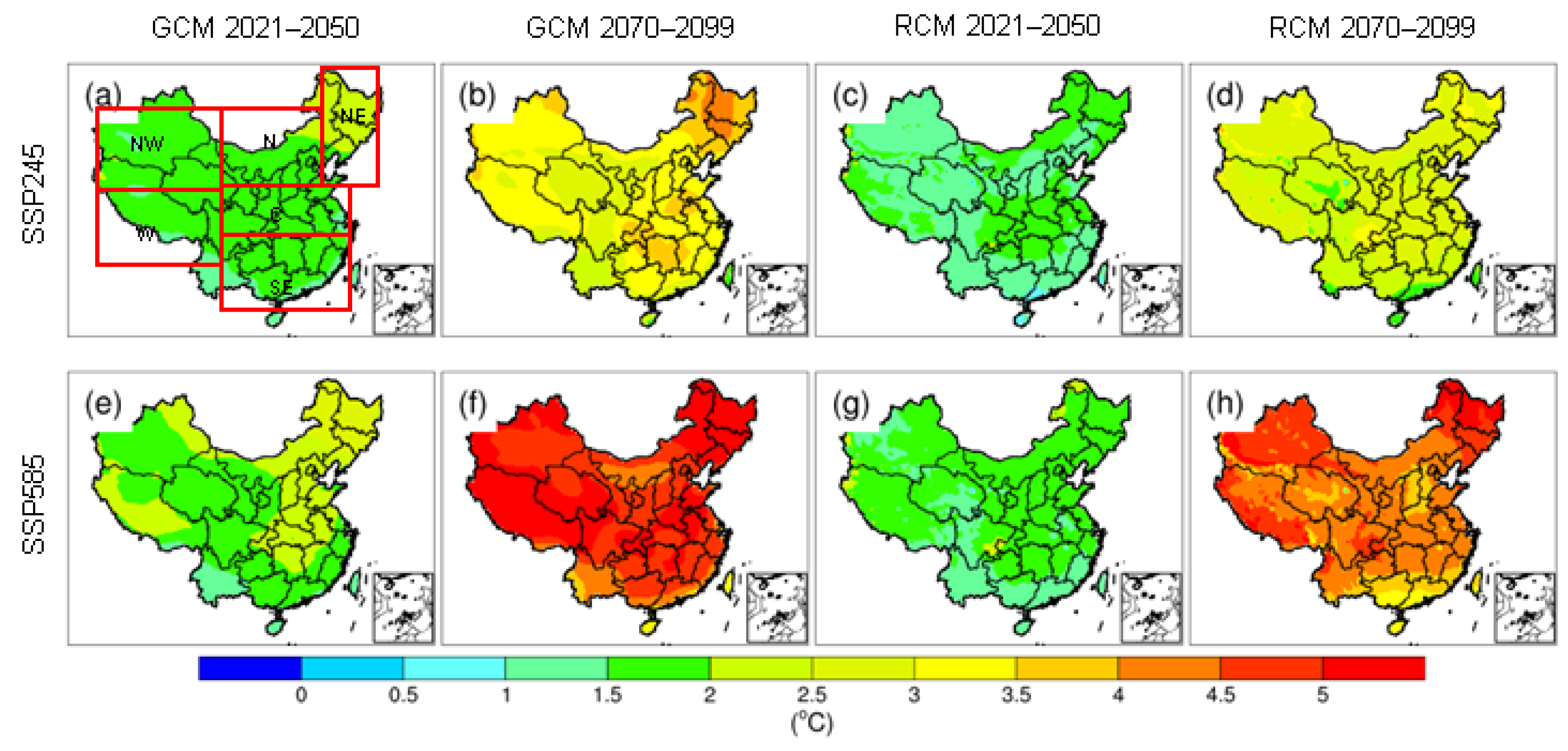
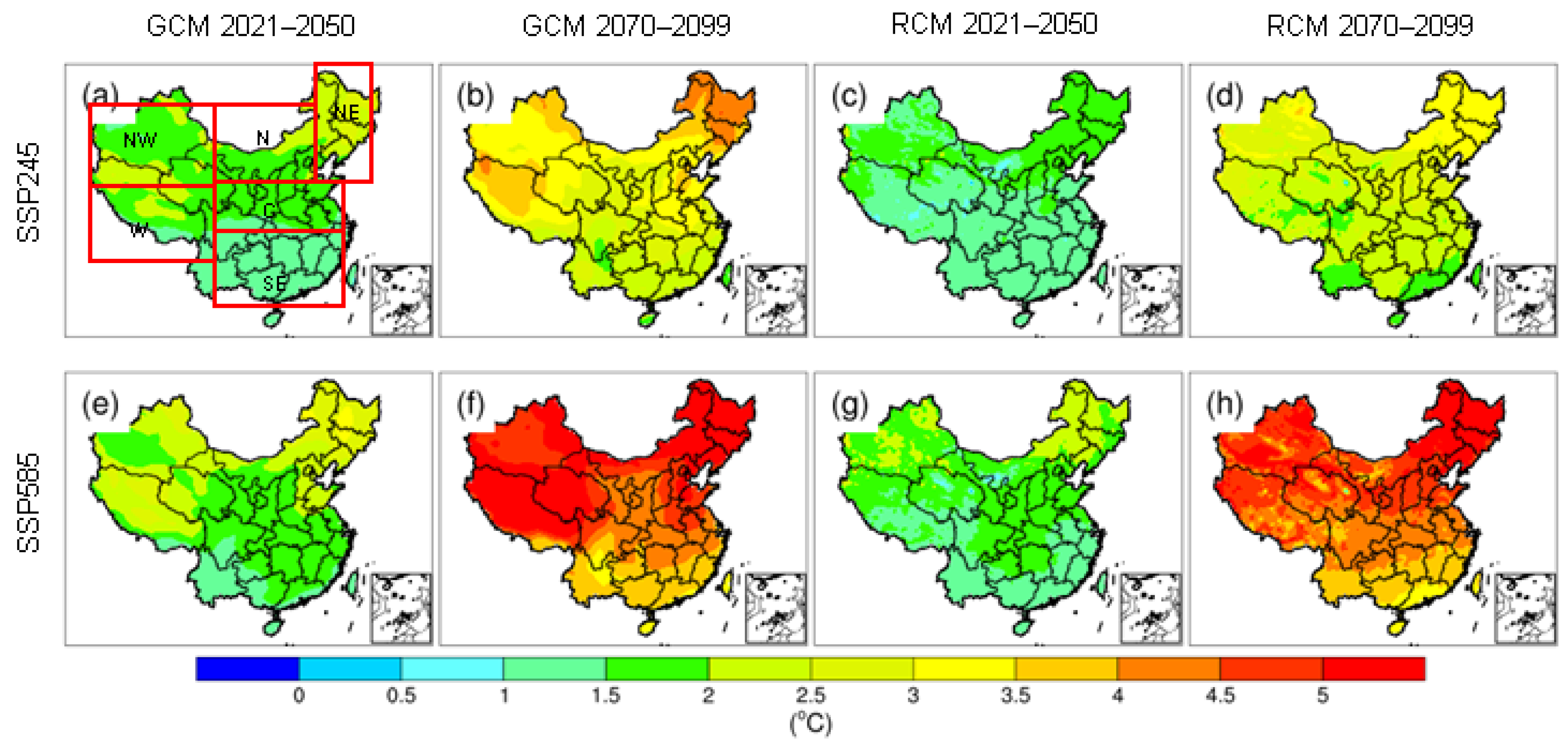
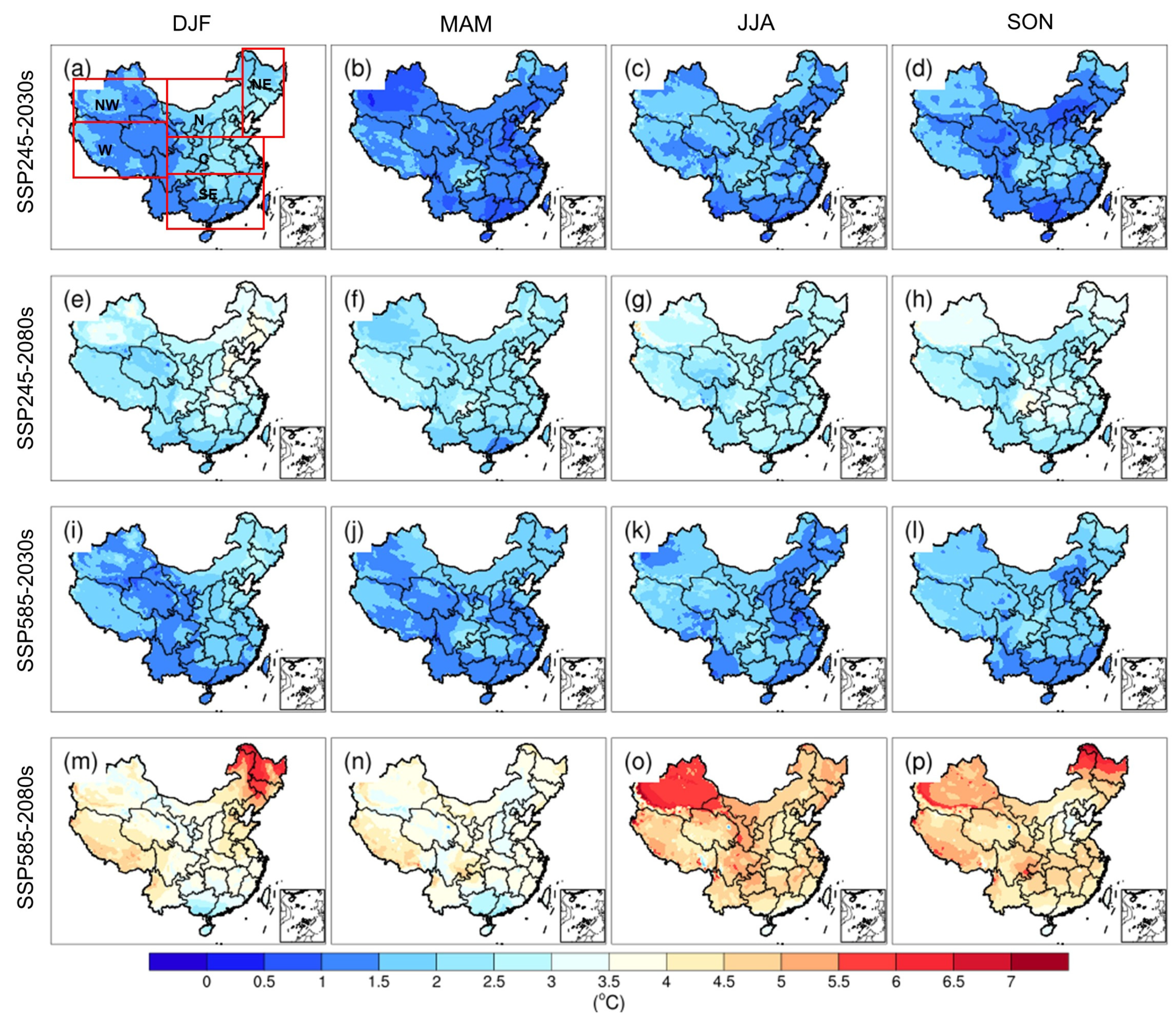
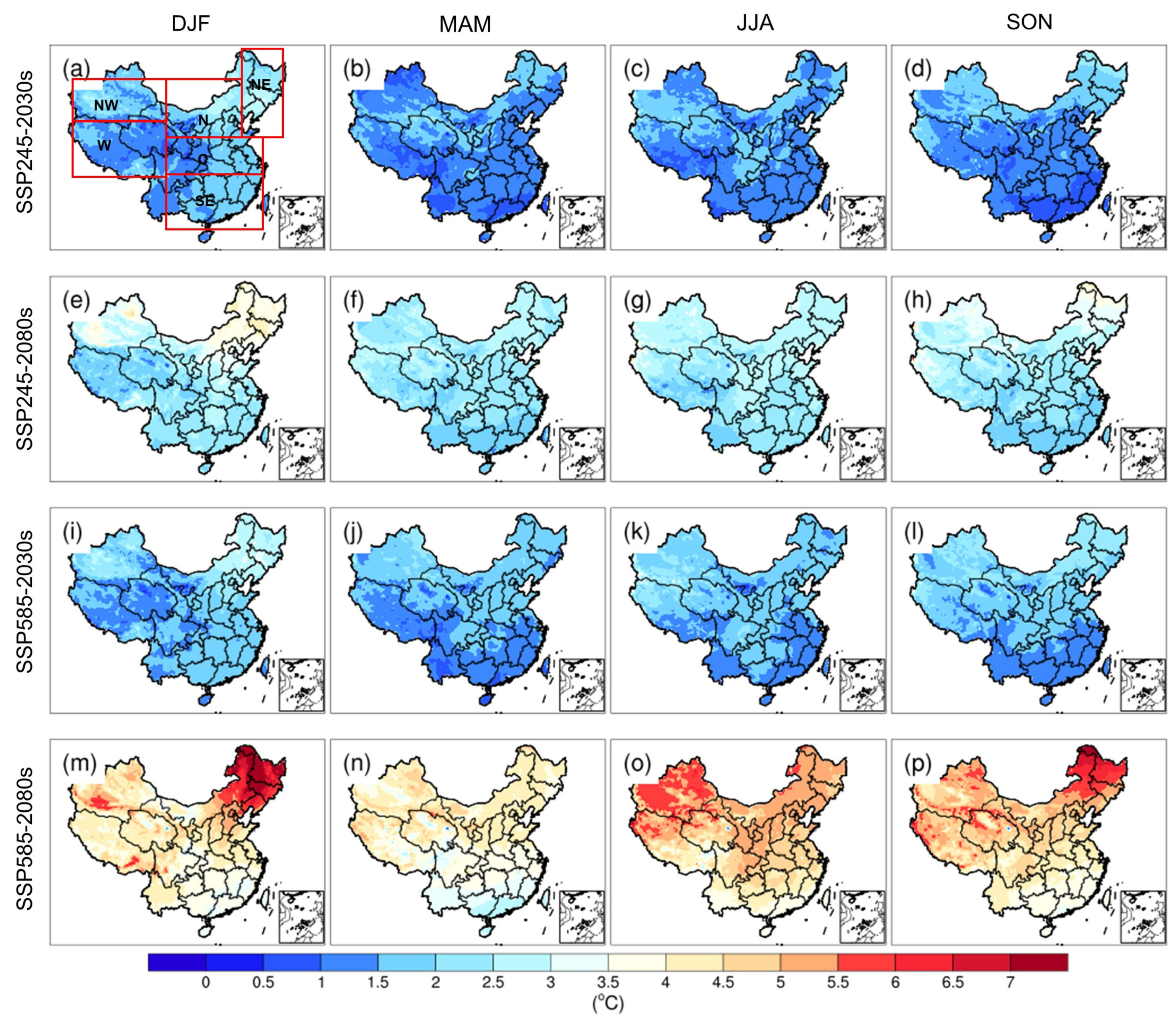
| Sub-Region | Longitude | Latitude |
|---|---|---|
| Northeast China (NE) | 123.3° E–135.2° E | 36.2° N–53.7° N |
| North China (N) | 96.7° E–123.3° E | 36.2° N–49.5° N |
| Northwest China (NW) | 73.2° E–96.7° E | 36.2° N–49.5° N |
| West China (W) | 78.2° E–103.1° E | 26.8° N–36.2° N |
| Southeast China (SE) | 103.1° E–123.1° E | 20.9° N–30.8° N |
| Central China (C) | 103.1° E–123.1° E | 30.8° N–36.2° N |
| Region | R | RMSE | MAE | |||
|---|---|---|---|---|---|---|
| GCM | RCM | GCM | RCM | GCM | RCM | |
| China | 0.961 (0.930) | 0.964 (0.940) | 4.186 (3.344) | 3.907 (3.647) | −2.88 (−1.96) | −1.38 (−1.85) |
| NE | 0.926 (0.914) | 0.99 (0.963) | 4.949 (2.977) | 1.462 (1.863) | −4.85 (−2.58) | −1.03 (1.16) |
| N | 0.987 (0.888) | 0.985 (0.887) | 3.308 (2.124) | 2.217 (2.441) | −2.90 (−1.20) | −0.49 (−1.08) |
| NW | 0.961 (0.845) | 0.944 (0.913) | 4.727 (3.083) | 4.641 (3.675) | −3.03 (−1.02) | −2.72 (−2.38) |
| SE | 0.989 (0.976) | 0.993 (0.992) | 3.17 (3.276) | 3.216 (1.697) | −0.10 (−1.83) | 1.96 (−0.09) |
| C | 0.998 (0.975) | 0.998 (0.985) | 2.171 (2.561) | 2.431 (1.601) | −1.90 (−2.02) | 1.87 (−0.98) |
| W | 0.692 (0.964) | 0.635 (0.964) | 5.515 (5.004) | 5.849 (6.213) | −4.54 (−3.85) | −4.94 (−5.73) |
Disclaimer/Publisher’s Note: The statements, opinions and data contained in all publications are solely those of the individual author(s) and contributor(s) and not of MDPI and/or the editor(s). MDPI and/or the editor(s) disclaim responsibility for any injury to people or property resulting from any ideas, methods, instructions or products referred to in the content. |
© 2024 by the authors. Licensee MDPI, Basel, Switzerland. This article is an open access article distributed under the terms and conditions of the Creative Commons Attribution (CC BY) license (https://creativecommons.org/licenses/by/4.0/).
Share and Cite
Guo, J.; Jia, H.; Wang, Y.; Wang, X.; Li, W. Dynamical Downscaling of Daily Extreme Temperatures over China Using PRECIS Model. Sustainability 2024, 16, 3030. https://doi.org/10.3390/su16073030
Guo J, Jia H, Wang Y, Wang X, Li W. Dynamical Downscaling of Daily Extreme Temperatures over China Using PRECIS Model. Sustainability. 2024; 16(7):3030. https://doi.org/10.3390/su16073030
Chicago/Turabian StyleGuo, Junhong, Hongtao Jia, Yuexin Wang, Xiaoxuan Wang, and Wei Li. 2024. "Dynamical Downscaling of Daily Extreme Temperatures over China Using PRECIS Model" Sustainability 16, no. 7: 3030. https://doi.org/10.3390/su16073030
APA StyleGuo, J., Jia, H., Wang, Y., Wang, X., & Li, W. (2024). Dynamical Downscaling of Daily Extreme Temperatures over China Using PRECIS Model. Sustainability, 16(7), 3030. https://doi.org/10.3390/su16073030





